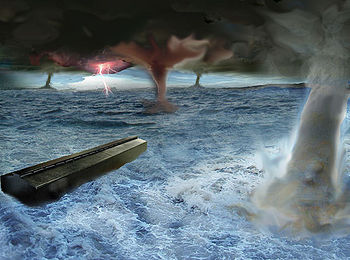“Noah’s flood” may have not been as biblical in proportion as previously thought
 Washington, Feb 7 : A new study has suggested that the ancient flood that some scientists think gave rise to the Noah story in the Bible may not have been so massive in proportion as earlier believed.
Washington, Feb 7 : A new study has suggested that the ancient flood that some scientists think gave rise to the Noah story in the Bible may not have been so massive in proportion as earlier believed.
Researchers generally agree that, during a warming period about 9,400 years ago, an onrush of seawater from the Mediterranean spurred a connection with the Black Sea, then a largely freshwater lake.
That flood turned the lake into a rapidly rising sea.
A previous theory said that the Black Sea rose up to 195 feet (60 meters), possibly burying villages and spawning the tale of Noah's flood and other inundation folklore.
But, according to a report in National Geographic News, the new study, which largely focused on relatively undisturbed underwater fossils, suggests a rise of no more than
30 feet (10 meters).
Marine geologist Liviu Giosan and colleagues carbon-dated the shells of pristine mollusk fossils, which the researchers say bear no evidence of epic flooding.
Found in sediment samples taken from where the Black Sea meets the Danube River, the shells "weren't eroded, agitated, or moved," said Giosan, of the Woods Hole Oceanographic Institute in Massachusetts.
"We know the mud is exactly the same age as the shells and so can determine what the sea level was about 9,400 years ago," he added.
The results suggest the Black Sea rose 15 to 30 feet (5 to 10 meters), rather than the 150 to 195 feet (50 to 60 meters) first suggested 13 years ago by Columbia University geologist William Ryan and colleagues.
In 1993, a Black Sea expedition found evidence of former shorelines and coastal dunes at depths of up to 390 feet (120 meters).
According to researchers, these areas had been flooded when the Mediterranean and the Sea of Marmara, which lies between the Mediterranean and the Black Sea, breached a rocky barrier across the Bosporus, the Turkish strait that links the Maramara with the Black Sea.
Before such a flood, Ryan and colleagues said the flooded regions may have been rife with agricultural settlements.
His research supports the notion that the flood submerged some 62,000 square miles (100,000 square kilometers), driving out farmers in droves, thereby supercharging the agricultural development of Europe, to the west.
However, Giosan's new study, indicates a less catastrophic influx, submerging only about 1,240 square miles (2,000 square kilometers).
That's because, according to the new study, the Black Sea's pre-flood water levels were significantly higher than Ryan's study suggested.
As a result, there may have been much less water cascading through the Bosporus and onto the exposed continental shelf surrounding the Black Sea. (ANI)